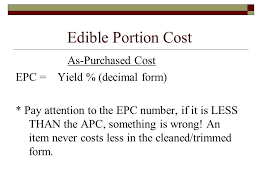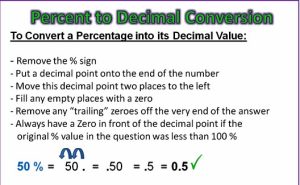26 Edible Portion Cost
As you work with yield percentages, you will notice that when you buy produce, the edible amount of what you buy is less than the food you actually buy. In other words, you get less than you pay for. Or, if you want to make sure that the edible portion of what you buy is enough for your recipe, you need to buy more than your recipe calls for. In other words, you pay for more than you get. So when you are trying to determine the actual cost of a recipe, you can use a formula with the yield percent to calculate the actual cost of the food you are buying. Here is the formula you can use:

Remember how to put yield percent into decimal form:

Finally, you still need to look up the yield percentages here.
Let’s put all this together. Let’s say that strawberries are priced at $3.49 per pound. This would be the as-purchased cost. The yield percent for strawberries is 87%. This converts to 0.87 in decimal form.
What is the edible portion cost for these strawberries?
The edible portion cost for these strawberries is $4.01 per pound, rounded to the nearest hundredth.
If whole pineapple is priced at $2.75 per pound, and the yield percent is 52%, what is the edible portion cost?
The edible portion cost for this pineapple is $5.29 per pound, rounded to the nearest hundredth.
This puts an anchor at the top of the page to link to within the page.
This is the Navigation section at the top of the page.
Assignment
Purpose
To practice finding the edible portion cost of various foods.
Outcomes
By completing this assignment, you will be able to…
- Use the formula given to make calculations.
- Calculate the edible portion cost when given the as-purchased cost.
Instructions
To complete this assignment…
-
- Use the formula to find the edible portion cost for each item given.
- Use the table here to find the yield percent.
- Round each answer to the nearest hundredth, if necessary.
- Be sure to show how you set up each problem.
Tips for Success
To help in the completion of this assignment, make sure to:
- Convert the yield percent to a decimal number.
- Round answers to the nearest hundredth.
- Include how you set up each problem in order to get credit.
Edible Portion Cost Assignment
What is the edible portion cost per pound for:
1) Bananas at $0.90 per pound
2) Apples at $1.06 per pound
3) Apricots at $1.15 per pound
4) Raspberries at $8.65 per pound
5) Figs at $2.18 per pound
6) Strawberries at $3.00 per pound
7) Oranges (to be sectioned) at $0.95 per pound
8) Lemons (for juice) at $1.50 per pound
9) Cantaloupe at $1.66 per pound
10) Sweet potatoes at $1.50 per pound
11) Zucchini at $1.54 per pound
12) Rhubarb at $3.55 per pound
13) Potatoes (old) at $0.26 per pound
14) Pears at $1.33 per pound
15) Carrots without tops at $0.69 per pound
16) Blackberries at $7.10 per pound
17) Blueberries at $1.40 per pound
18) Honeydew without rind at $4.29 per pound

